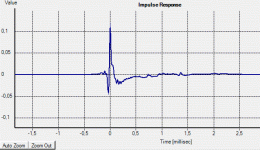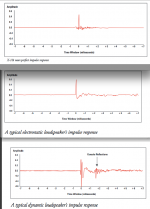It doesn't look right Earl. Assuming you Summa has a low frequency cut off around 40 to 80 Hz I would expect the impulse of a MP band pass system with such a low frequency cut off and a 12k high frequency cut off to have much less of a negative swing after the first positive. What you are showing looks more like a MP system with low frequency cut off around 1k Hz, or a 40 to 12k system with 2nd or 3rd order crossover around 1k and one driver inverted. Simulation of any of those systems will yield an impulse that looks pretty much the same even though only one of the 3 is MP. That's why looking at phase is necessary. It's just not clear in the impulse. The impulse may look MP while the system in not. From the phase it is known that the total phase rotation is determined by the phase rotation due to the low and high frequency cut offs. If the low frequency roll at order n and the high frequency roll at order m then the total phase rotation is (n+m) x 90 degrees and you have to make sure the phase asymptotes to m x 90 in the phase plot. That is, you can not removed delay to make things "look" like they are M P.
Not that any of this matters. I'm going back into hibernation.
Not that any of this matters. I'm going back into hibernation.
If you have massively expensive speakers, they are focused razor sharp and each sound is distinct. Call it clarity, call it transparency, call it Mary, call it what you will, but when you hear it, you know it.
What causes this? Any number of things. Modulation or non-pistonic action of the cones, Harmonic Distortion, Timing errors, phase shift, poor crossovers, poor cabinet tuning, poor general design.
We all do the best we can within the budgets we have. Sadly I always have a too low budget
I noticed that this is simply a characteristics of expensive woofers' cone behaviour: Light cone, rigid cone, "linear" magnet (flux). Of course they can be made "wrong" (but that's a pity) but I have never heard such "transparency" with drivers of opposite characteristics. Take Scan-Speak woofers for example, you can see the progression from the cheaper models to the expensive models, and so is the Seas (I really want to hear the difference between Magnesium and Nextel coated paper tho).
Not that any of this matters.
John
Basically that's what I think as well.
My comments about MP were just casual guesses, I don't really care if the system is MP or not. I do care if the impulse does not ring out, kind of like the waterfall plots, although I don't see those as showing anything that the impulse response doesn't show. I have no real proof that this matters either other than the more compact I made the impulse responses the better the systems seemed to sound.
And the whole point of this thread was to look at things that we don't usually look at to see if we can explain some aspects that others seem to believe are audible. My position is that unless it is somehow quantifiable its just a guessing game and I don't have time for those.
I'm going back into hibernation.
I do wish that you wouldn't hibernate, you are one of the few people around here who has valid and pertinent comments.
Last edited:
And the whole point of this thread was to look at things that we don't usually look at to see if we can explain some aspects that others seem to believe are audible.
There is nothing new here. The impulse response is just one of a few things that together define the quality of a loudspeaker. Of course the impulse response of the Summa is very good and it surely contributes to the overall quality.
The analogy of this perfect impulse response of a loudspeaker is the perfect square wave test of an amplifier.
It is a pity that many do not have ears so that they cannot relate figures with perceived sound.
To make a "dark" background sound, this is what you can do:
(1) The cone and motor technology is the limiting factor. We want a light but rigid cone. The motor will help the cone if the flux is homogen. In other words we want a perfect piston.
(2) The amplifier must have high slew rate (this is debatable for some). This will have good response on square wave. Current Feedback Amps tend to do it well. But the line level amplifiers should not be a bottleneck.
(3) Crossover design. I think it is not difficult, but we can try to get the optimum "darkness". How? I have no idea. My focus is with phase. When phase characteristics is good, almost everything else is good. But I rely on ears. It means I can swept various kind of roll-off rate and XO frequencies to find the sweetspot of each driver.
(4) Enclosure design: Baffle resonance.
(1) The cone and motor technology is the limiting factor. We want a light but rigid cone. The motor will help the cone if the flux is homogen. In other words we want a perfect piston.
(2) The amplifier must have high slew rate (this is debatable for some). This will have good response on square wave. Current Feedback Amps tend to do it well. But the line level amplifiers should not be a bottleneck.
(3) Crossover design. I think it is not difficult, but we can try to get the optimum "darkness". How? I have no idea. My focus is with phase. When phase characteristics is good, almost everything else is good. But I rely on ears. It means I can swept various kind of roll-off rate and XO frequencies to find the sweetspot of each driver.
(4) Enclosure design: Baffle resonance.
I had forgotten about this thread and that Pano and Earl posted sample impulse responses. Thanks! And thanks to Andrew as well.
Interesting discussion. I would also tend to think that "good" impulse response is something closer to the dirac function. Quick decay is good, but other than that I still feel like I need to look at the amplitude and phase to decipher what it's going to sound like.
Interesting discussion. I would also tend to think that "good" impulse response is something closer to the dirac function. Quick decay is good, but other than that I still feel like I need to look at the amplitude and phase to decipher what it's going to sound like.
An acoustic impulse response can never be a Dirac (Dirac is a family name) function because a DC shift in pressure is not possible (not in an open space). There has to be a negative swing in direct proportion to the positive - no DC is possible. An acoustic impulse must always average to zero.
This piece of a paper written by John Dunlavy shows interesting impulse response:

That last impulse response example of a Dunlavy speaker sure looks compact.
Not a big negative peak after the positive pulse.
Source: Legacy Whisper Dunlavy SC V opinions - Page 10

That last impulse response example of a Dunlavy speaker sure looks compact.
Not a big negative peak after the positive pulse.
Source: Legacy Whisper Dunlavy SC V opinions - Page 10
I don't see how the last one is possible. It does not average to zero and hence it will have changed the static pressure of the world.
That came straight from John Dunlavy's papers. From the interview with Dunlavy by stereophile he seemed quite serious about measurements of impulse and step response. It appeared to have had his main focus at the time.
The one in the Stereophile SC-IV/A review seems more reasonable:
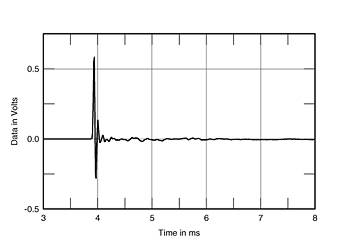
The one in the Stereophile SC-IV/A review seems more reasonable:

Last edited:
Clearly, we cannot achieve the perfect impulse from a loudspeaker. But it can get close, like Barleywater showed a few posts ago. Anyway, the discussion was whether it is possible to detect from an impulse whether the loudspeaker sounded good or not. There are definitely clues to point at obvious problems, but not enough clues to differentiate one good speaker from another.
Maybe not entirely, but it's certainly very useful information. With some experience, you should be able to tease a lot of speaker qualities out of an impulse response (by eye).
I think I found a similar measurement for that impulse response in the Dunlavy papers:
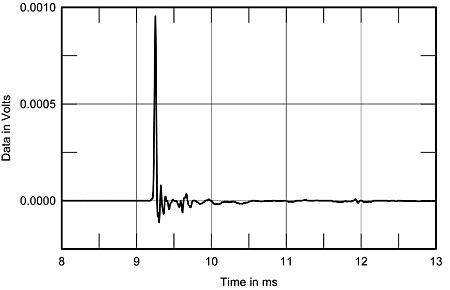
Dunlavy Audio Laboratories SC-IV loudspeaker Measurements | Stereophile.com
Compare it to this (as John Atkinson mentioned in his write up):
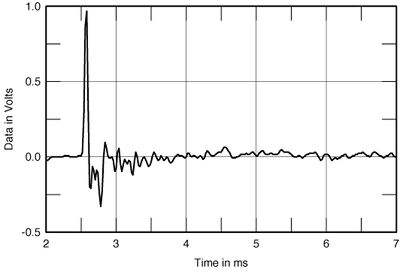
for a Quad ESL-63
Quad ESL-63 loudspeaker Measurements | Stereophile.com
Impossible?

Dunlavy Audio Laboratories SC-IV loudspeaker Measurements | Stereophile.com
Compare it to this (as John Atkinson mentioned in his write up):

for a Quad ESL-63
Quad ESL-63 loudspeaker Measurements | Stereophile.com
Impossible?
Last edited:
I don't see how the last one is possible. It does not average to zero and hence it will have changed the static pressure of the world.
Here is an old design on mine. Except for the fact that the impulse is upside down....
TP-3W-D-1
Originally Posted by gedlee
I don't see how the last one is possible. It does not average to zero and hence it will have changed the static pressure of the world.
HF compression drivers duplicate the + part of the waveshape better at high SPL than the -, as the - (rarifaction wave) can't pull more than a vacuum, while the positive (compression wave) could theoretically push until the air becomes liquid.
I wonder if the larger positive impulse spike is the result of air non-linearity in sound transmission?
I don't see how the last one is possible. It does not average to zero and hence it will have changed the static pressure of the world.
Seems your polarity reverse shows the usual leading edge +amplitude higher than the -amplitude, which I have noticed in the impulse response of other speakers with good transient response.Here is an old design on mine. Except for the fact that the impulse is upside down....
HF compression drivers duplicate the + part of the waveshape better at high SPL than the -, as the - (rarifaction wave) can't pull more than a vacuum, while the positive (compression wave) could theoretically push until the air becomes liquid.
I wonder if the larger positive impulse spike is the result of air non-linearity in sound transmission?
Attachments
Can anyone explain to me how an impulse response of an acoustic transducer can not average to zero?
If it does not average to zero then something was done wrong or manipulated in an non-acoustic domain.
If it does not average to zero then something was done wrong or manipulated in an non-acoustic domain.
Clearly, we cannot achieve the perfect impulse from a loudspeaker. But it can get close, like Barleywater showed a few posts ago. Anyway, the discussion was whether it is possible to detect from an impulse whether the loudspeaker sounded good or not. There are definitely clues to point at obvious problems, but not enough clues to differentiate one good speaker from another.
----------------------------------Can anyone explain to me how an impulse response of an acoustic transducer can not average to zero?
If it does not average to zero then something was done wrong or manipulated in an non-acoustic domain.
Well, if it does not average to zero, then be very careful not to open the window. If you do, the room will implode.
it has to average to zero in terms of area beneath and above the curve, not amplitude. That can be over long times to approach balance and still be high-pass. The amplitude may be too small to see on the IR.
You are missing the point, the transducer-room as a system is not producing DC. That is Earl's point and that is the source of my "caution" about the implosion. But are correct, the average should not have DC.
Last edited:
- Status
- Not open for further replies.
- Home
- Loudspeakers
- Multi-Way
- Speaker Clarity as "Darkness" - please chime in
